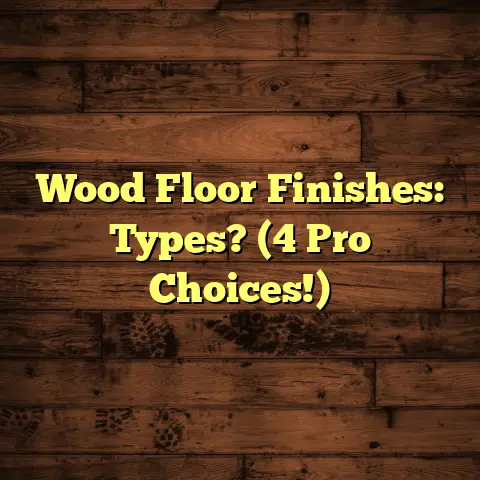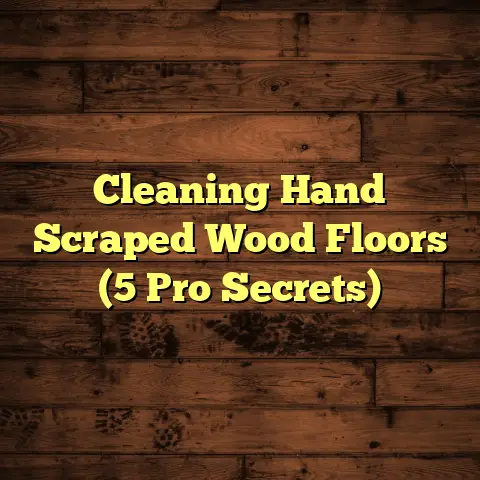Burnish Floors After Wax? (1 Hour Could Ruin It!)
Ever spent a whole Saturday waxing your hardwood floors, admiring that mirror-like shine, only to wonder if you should take it to the next level with a burnisher?
I’ve been there, staring at my handiwork, asking myself that exact question.
But let me tell you, that moment of hesitation is crucial. One wrong move with a burnisher, even just an hour after waxing, can turn that beautiful finish into a streaky, dull mess. Trust me, I’ve seen it (and fixed it!) more times than I’d like to admit.
This isn’t just about aesthetics, either. We’re talking about the very durability and longevity of your flooring. So, grab a coffee (or your beverage of choice), and let’s dive deep into the do’s and don’ts of burnishing after waxing. I’m going to share my insider knowledge – the stuff they don’t tell you in the YouTube tutorials!
Section 1: Understanding the Basics of Floor Waxing and Burnishing
Okay, let’s get our terminology straight. Think of this as Flooring 101, but with real-world application.
1. Definition of Floor Waxing
Floor waxing is essentially applying a protective coating to your floor. This isn’t your grandma’s paste wax that took all day to buff out. Today, we have everything from solvent-based waxes to water-based acrylic finishes.
The main benefits?
- Protection: Wax acts as a sacrificial layer, guarding against scratches, scuffs, and spills.
- Shine: A freshly waxed floor looks fantastic! It reflects light and adds warmth to the room.
- Ease of Cleaning: Waxed floors are generally easier to sweep and mop.
But here’s the kicker: not all floors are created equal, and neither are waxes.
Suitable Flooring Materials:
- Wood: Specifically hardwood, although engineered wood can sometimes be waxed (check with the manufacturer!). I typically recommend a paste wax for wood.
- Vinyl: Luxury Vinyl Tile (LVT) and vinyl composition tile (VCT) are common candidates for waxing. Use an acrylic floor finish for vinyl.
- Linoleum: Similar to vinyl, linoleum benefits from waxing to protect its surface. Again, an acrylic floor finish is a good choice.
Important Note: Never wax laminate flooring! It can damage the surface.
2. Definition of Burnishing
Burnishing is like giving your waxed floor a high-speed massage. It uses a floor machine (a “burnisher”) with a special pad to generate heat and friction.
What’s the point?
- Enhanced Gloss: Burnishing melts the top layer of wax, creating a smoother, more reflective surface.
- Smooth Surface: It helps to even out minor imperfections in the wax coating.
Think of it like ironing out wrinkles in a shirt – but for your floor.
3. The Chemistry Behind Wax and Burnishing
This is where things get interesting. Wax, at its core, is a collection of polymers. When you apply it, these polymers are somewhat disorganized.
Burnishing introduces heat and pressure. This energy causes the polymers to realign and cross-link, creating a tighter, more uniform structure. This is what gives you that super-shiny, durable finish.
But here’s the crucial part: the wax needs to be ready for this realignment. If it’s still soft and hasn’t fully cured, burnishing can disrupt the process, leading to cloudiness, streaks, or even complete wax failure.
The temperature generated during burnishing can range from 150°F to 200°F (65°C to 93°C), depending on the machine and pad used. The pressure also plays a key role, typically ranging from 5 to 10 pounds per square inch (PSI).
Section 2: Timing is Everything – The Risks of Burnishing Too Soon
Okay, remember that “moment of hesitation” I mentioned at the beginning? This is why it’s so critical.
1. The Importance of Curing Time
Curing is the process where the wax completely hardens and bonds to the floor. This isn’t just about the surface feeling dry to the touch. It’s about the chemical reactions happening at a microscopic level.
Factors Affecting Curing Time:
- Type of Wax: Solvent-based waxes generally cure faster than water-based ones.
- Humidity: High humidity can slow down the curing process.
- Temperature: Warmer temperatures typically speed up curing.
Typical Curing Times:
| Type of Wax | Minimum Curing Time |
|---|---|
| Solvent-Based | 24 Hours |
| Water-Based Acrylic | 48-72 Hours |
The “Curing Window”:
Think of this as the Goldilocks zone. You need to wait long enough for the wax to cure properly, but not so long that it becomes too hard to burnish effectively.
Burnishing too early can lead to:
- Cloudiness: The wax hasn’t fully hardened, so the burnishing pad smears it around instead of polishing it.
- Streaking: Uneven pressure or a soft wax layer can create visible streaks.
- Delamination: The wax layer can separate from the floor, leading to peeling and flaking.
2. Case Studies and Anecdotes
Let me share a story from my early days as a flooring contractor. I had a client with a beautiful VCT floor in their retail store. They wanted a super-glossy finish, so I waxed and burnished it.
But, eager to impress, I burnished it only 24 hours after applying a water-based acrylic finish. Big mistake!
The result? The floor looked great for about a week, then started developing cloudy patches and streaks. I had to completely strip the floor and start over, costing me time and money.
I’ve also seen homeowners try to burnish their floors after only a few hours, thinking they could speed up the process. They ended up with a gummy, uneven mess that required professional intervention.
The lesson here? Patience is a virtue, especially when it comes to floor waxing and burnishing.
Section 3: The Right Technique for Burnishing After Waxing
Okay, so you’ve waited the appropriate amount of time. Now what? Let’s talk technique.
1. Preparation for Burnishing
Preparation is key to a successful burnishing job.
Steps:
- Assess the Wax’s Readiness: Gently press your fingernail into an inconspicuous area of the floor. If it leaves a deep indentation, the wax isn’t ready. It should feel firm and slightly flexible.
- Clean the Floor Thoroughly: Remove all dirt, dust, and debris. Use a neutral floor cleaner and a microfiber mop.
- Dry the Floor Completely: Any moisture can interfere with the burnishing process.
2. Choosing the Right Equipment
The burnisher is your weapon of choice, so choose wisely.
Types of Burnishers:
- Low-Speed Burnishers (175-300 RPM): These are good for general cleaning and light burnishing. They are great for applying the wax.
- High-Speed Burnishers (1000-3000 RPM): These are designed for achieving a high-gloss finish.
- Ultra-High-Speed Burnishers (Over 3000 RPM): These are typically used in commercial settings for maximum shine.
Burnishing Pads:
- White Pads: These are the least abrasive and are used for polishing and light burnishing.
- Beige Pads: These are slightly more abrasive and are used for removing light scratches and scuffs.
- Red Pads: These are more aggressive and are used for heavier burnishing and scrubbing.
Choosing the Right Pad:
For burnishing after waxing, I generally recommend a white or beige pad. You want to enhance the shine without removing too much wax.
3. The Burnishing Process
Alright, let’s get down to business.
Step-by-Step Guide:
- Attach the Burnishing Pad: Make sure it’s securely attached to the burnisher.
- Start in a Corner: This allows you to test your technique and adjust as needed.
- Use a Consistent Overlap: Overlap each pass by about 50% to ensure even coverage.
- Keep the Burnisher Moving: Don’t let it sit in one spot for too long, or you risk overheating the wax.
- Use Light Pressure: Let the weight of the machine do the work.
Common Mistakes to Avoid:
- Using Too Much Pressure: This can damage the wax and the floor.
- Burnishing in One Spot: This can cause burn marks.
- Using a Dirty Pad: This can scratch the floor.
Section 4: Signs That Burnishing May Have Ruined the Wax Finish
Uh oh. Something doesn’t look right. How do you know if you’ve messed up the wax finish?
1. Visual Indicators
- Dulling: The floor looks less shiny than it did before burnishing.
- Streaking: Visible lines or streaks appear on the surface.
- Uneven Gloss: Some areas are shiny, while others are dull.
- Hazing: A cloudy or milky appearance on the floor.
2. Performance Issues
- Increased Susceptibility to Dirt: The wax finish is now more porous and attracts dirt.
- Scuffing: The floor scuffs easily, even with light foot traffic.
- Loss of Protection: The wax is no longer providing adequate protection against spills and scratches.
Section 5: The Recovery Process
Okay, damage is done. What now? Don’t panic!
1. Assessing the Damage
Self-Assessment Checklist:
- Is the damage localized or widespread?
- Is the wax finish completely ruined, or can it be salvaged?
- Is the floor itself damaged?
If the damage is minor (e.g., a few streaks or dull spots), you might be able to fix it with a light re-burnishing. But if the wax finish is completely ruined, you’ll need to strip it and start over.
2. Repairing and Restoring the Finish
Steps:
- Stripping the Wax: Use a commercial wax stripper and follow the manufacturer’s instructions.
- Cleaning the Floor: Thoroughly clean the floor to remove any remaining stripper residue.
- Applying New Wax: Apply several thin coats of wax, allowing each coat to dry completely before applying the next.
- Burnishing (Correctly This Time!): Wait the appropriate amount of time for the wax to cure, then burnish using the correct technique.
Conclusion: Making Informed Decisions on Burnishing After Waxing
So, there you have it. Burnishing after waxing can be a great way to enhance the beauty and durability of your floors. But it requires careful timing, the right equipment, and a healthy dose of patience.
Remember, that “moment of hesitation” is your friend. Take the time to assess the wax’s readiness, choose the right equipment, and follow the proper technique.
By making informed decisions, you can achieve a stunning floor finish without ruining hours of hard work. And if you’re ever in doubt, don’t hesitate to call a professional. Sometimes, it’s better to be safe than sorry!
Happy burnishing (the right way!), folks!





